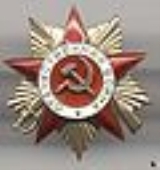
Order of the Patriotic War
Encyclopedia
 |
 |
The Order of the Patriotic War is a Soviet
Soviet Union
The Soviet Union , officially the Union of Soviet Socialist Republics , was a constitutionally socialist state that existed in Eurasia between 1922 and 1991....
military decoration
Order (decoration)
An order or order of merit is a visible honour, awarded by a government, dynastic house or international organization to an individual, usually in recognition of distinguished service to a nation or to humanity. The distinction between orders and decorations is somewhat vague, except that most...
that was awarded to all soldiers in the Soviet armed forces, security troops, and to partisans
Partisan (military)
A partisan is a member of an irregular military force formed to oppose control of an area by a foreign power or by an army of occupation by some kind of insurgent activity...
for heroic deeds during the German-Soviet War
Eastern Front (World War II)
The Eastern Front of World War II was a theatre of World War II between the European Axis powers and co-belligerent Finland against the Soviet Union, Poland, and some other Allies which encompassed Northern, Southern and Eastern Europe from 22 June 1941 to 9 May 1945...
, known by the former-Soviet Union as the Great Patriotic War
Great Patriotic War (term)
The term Great Patriotic War , Velíkaya Otéchestvennaya voyná,) is used in Russia and some other states of the former Soviet Union to describe the portion of World War II from 22 June 1941 to 9 May 1945, against Nazi Germany and its allies in the many fronts of Soviet-German war.-History:The term...
.
History
The Order was established on 20 May 1942 and came in first class and second class depending upon the merit of the deed. It was the first Soviet medal established during the war, and the first Soviet order divided by classes. Its statute precisely defined, which deeds are awarded with the order, e.g. shooting down three aircraft as a fighter pilot, or destroying two heavy or three medium or four light tanks, or capturing a warship, or repairing an aircraft under fire after landing on a hostile territory, and so on, were awarded with the first class. It was also given to some allied troops and commanders, including western allies. Altogether, over 324,903 of the 1st class and 951,652 of the 2nd class were issued during the war. Until 1985, the total number reached about 1,370,000.In 1985 during the celebration of the 40th anniversary of the Second World War, it was decided that all surviving veterans of the war would be awarded either 2nd or 1st class of the Order, and about 2,054,000 first class and 5,408,000 second class were issued then.
As of January 1992, the total number of all awarded Orders was 2,487,098 first class and 6,688,497 second class variants.
Design
It featured a red enamel five-pointed star, made of silver, with straight rays in the background, and crossed sabre and rifle. The rays in the background were goldGold
Gold is a chemical element with the symbol Au and an atomic number of 79. Gold is a dense, soft, shiny, malleable and ductile metal. Pure gold has a bright yellow color and luster traditionally considered attractive, which it maintains without oxidizing in air or water. Chemically, gold is a...
en for 1st Class and silver for 2nd Class. The central disc had a golden hammer and sickle
Hammer and sickle
The hammer and sickle is a part of communist symbolism and its usage indicates an association with Communism, a Communist party, or a Communist state. It features a hammer and a sickle overlapping each other. The two tools are symbols of the industrial proletariat and the peasantry; placing them...
on a red enamel background, surrounded by a white enamel ring with the words ОТЕЧЕСТВЕННАЯ ВОЙНА ("Patriotic War"). Originally the Order was attached to a plain red ribbon much like the Gold Star
Gold Star
The Gold Star medal is a special insignia that identifies recipients of the title "Hero" in the Soviet Union and its communist allies, and several post-Soviet states.-Soviet origin:...
award, but from June 1943 the Order was to be worn on the right chest without ribbon; on less formal occasions a ribbon bar, dark red with a bright red central stripe for the 1st Class, or dark red with bright red edge stripes for the 2nd Class, may be worn instead.
Anniversary orders of 1985 were made cheaper, as a single silver piece, gold-plated in the 1st class.

